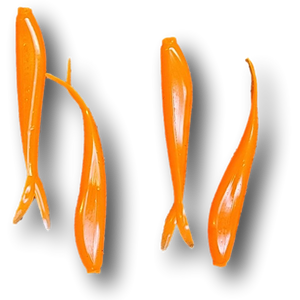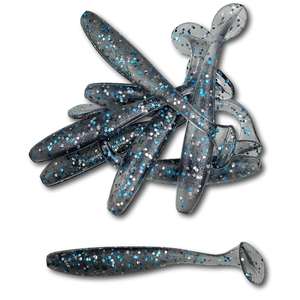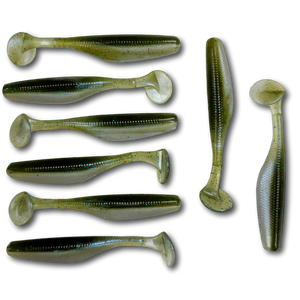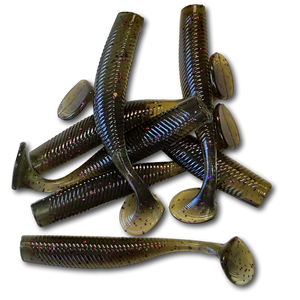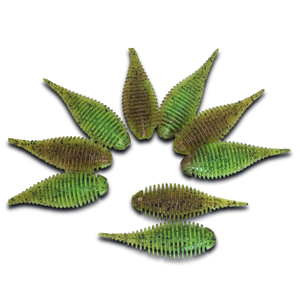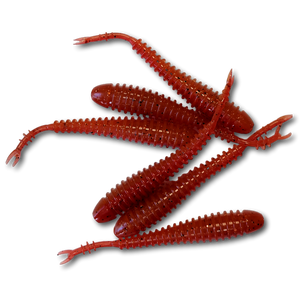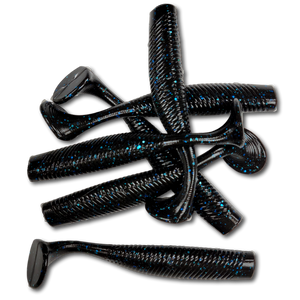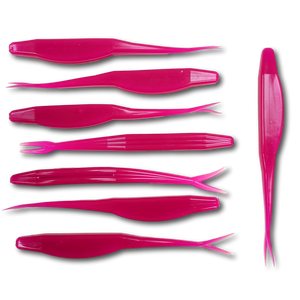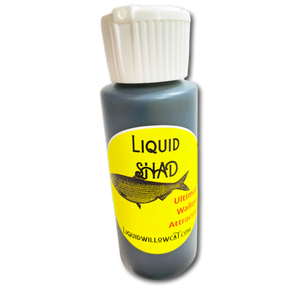Shad are a primary food source for many predatory fish, making them a key profile for soft plastic baits. These baits are designed to replicate the shape, movement, and subtle vibrations of live shad, triggering both feeding and reaction strikes.
Soft plastic shad baits are typically equipped with paddle tails, which create a lifelike swimming motion. Their compact bodies make them perfect for rigging in a variety of ways, allowing anglers to target fish in different depths and conditions.
Shad baits are highly effective because they replicate one of the most abundant and recognizable prey items in freshwater fisheries. Predatory species like bass, crappie, and walleye are naturally drawn to their shape, size, and swimming action.
The lifelike movement of the paddle tail and the ability to add custom rigging options make shad baits a go-to lure for anglers looking to match the hatch. Whether fish are feeding aggressively or are more finicky, shad baits are versatile enough to adapt.
Shad baits can be rigged in various ways to match the fishing environment and target species:
Swim Jig Head:
- Thread the shad onto a jig head for a streamlined and natural swimming action.
- Perfect for covering water quickly or targeting fish near rocky points, grass edges, or submerged timber.
Weightless Rig:
- Rig the shad weightless for a slow, natural glide through shallow water.
- Ideal for targeting fish holding near the surface or in clear water conditions.
Drop Shot Rig:
- Nose-hook the shad to keep it suspended and hovering above the bottom.
- Effective for smallmouth bass, crappie, or walleye near ledges, rocky areas, or deeper water.
Texas Rig:
- Use a weedless Texas rig to fish shad baits in heavy cover, such as grass beds or around brush piles.
- Great for targeting bass in snag-prone areas.
As a Trailer:
- Attach the shad to spinnerbaits, chatterbaits, or bladed jigs to add lifelike movement and bulk.
- Perfect for enticing strikes in stained water or when fish are actively chasing baitfish.
Vertical Jigging:
- Pair the shad with a heavier jig head for vertical jigging in deep water.
- Ideal for targeting walleye, lake trout, or other bottom-oriented species.
When and Where to Use Shad Baits
Shad baits are effective year-round and can adapt to a wide range of fishing scenarios:
- Spring: Fish shad baits in shallow flats, grass edges, or near spawning beds to target pre-spawn and spawning fish.
- Summer: Use shad baits in deeper water near ledges, drop-offs, or thermoclines where fish are holding.
- Fall: Mimic schooling baitfish near transition zones, open water, or along riprap as fish feed aggressively in preparation for winter.
- Winter: Scale down your presentation and jig shad baits near deep structure to entice lethargic fish.
Shad baits perform best in lakes, reservoirs, rivers, and ponds, particularly in areas where shad or similar forage fish are abundant.
Best Colors and Sizes for Shad Baits
Choosing the right color and size is crucial for matching forage and water conditions:
- Natural Colors: Silver, white, and translucent patterns are perfect for clear water or mimicking live shad.
- Bright Colors: Chartreuse, pink, or orange work well in stained or murky water.
- Dark Colors: Black, junebug, or purple create a strong silhouette for low-light conditions.
Shad baits typically range from 2.5 to 6 inches. Smaller sizes are ideal for crappie, panfish, or finicky bass, while larger profiles work well for trophy bass, walleye, or pike.
Why Every Angler Should Carry Shad Baits
Shad baits are an essential tool for anglers targeting predatory fish in freshwater environments. Their lifelike action, versatility, and ability to match one of the most common prey items make them a reliable choice for consistent success.
Whether you’re fishing shallow cover, deep structure, or open water, shad baits excel in delivering results. Their adaptability to various rigs and presentations makes them a must-have for both novice and experienced anglers.
Tips for Fishing Shad Baits
- Match the Hatch: Select colors and sizes that resemble the shad in your local waters.
- Experiment with Retrieve Speeds: Vary your retrieve speed to match fish activity levels and conditions.
- Focus on Structure: Target areas like grass lines, rocky points, or submerged timber where baitfish are likely to congregate.
- Use the Right Gear: Pair shad baits with a medium to medium-heavy rod and line suited for your target species.
Shad baits are a must-have for anglers looking to mimic one of the most common forage species in freshwater ecosystems. Their lifelike movement, versatility, and effectiveness make them a reliable choice for targeting bass, walleye, crappie, and more. Whether you’re fishing shallow flats, deep ledges, or open water, shad baits are built to deliver. Stock up on your favorite styles, sizes, and colors, and let shad baits bring more bites to your next fishing adventure.
Qwik Catches!




